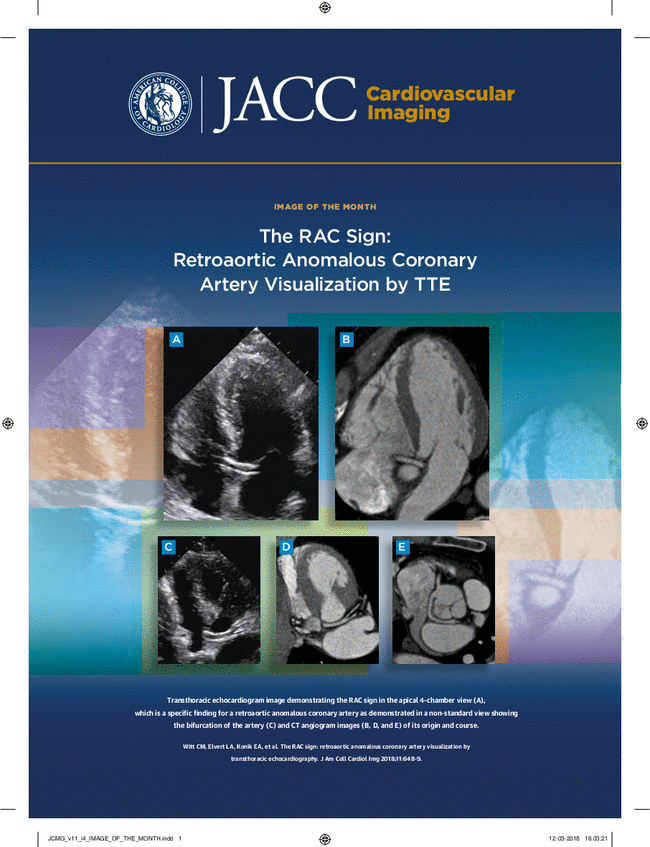Feature Tracking-Derived Global Longitudinal Strain Enhances Risk Stratification for Sudden Cardiac Death in Hypertrophic Cardiomyopathy.
IF 15.2
1区 医学
Q1 CARDIAC & CARDIOVASCULAR SYSTEMS
引用次数: 0
Abstract
BACKGROUND Left ventricular (LV)-global longitudinal strain (GLS) assessed by cardiac magnetic resonance (CMR) feature tracking is an emerging marker for predicting adverse outcomes in hypertrophic cardiomyopathy (HCM), but its incremental prognostic value and mechanistic role in sudden cardiac death (SCD) risk stratification remain unclear. OBJECTIVES The study sought to evaluate whether LV-GLS adds prognostic value beyond current ESC (European Society of Cardiology) and ACC (American College of Cardiology)/AHA (American Heart Association) SCD risk models, and mediates the relationship between myocardial abnormalities and SCD risk in HCM. METHODS The authors retrospectively analyzed 2,009 patients with HCM (mean age: 50 ± 14 years, 70% men) who underwent CMR between 2010 and 2017. LV-GLS was quantified using cine CMR feature tracking. The primary endpoint included SCD and aborted SCD. Prognostic performance was assessed using time-dependent receiver-operating characteristic analysis and competing risk regression. Mediation analysis was used to investigate how LV-GLS mediated associations between myocardial hypertrophy, fibrosis, and SCD. RESULTS Over a median follow-up of 88.2 months, 85 (4.2%) patients experienced SCD events. These patients had significantly lower absolute LV-GLS values (9.0% ± 3.6% vs 11.1% ± 3.6%; P < 0.001). In competing-risk regression, LV-GLS independently predicted SCD after adjustment for ESC (subdistribution HR [sHR]: 1.12 per 1% decrease [95% CI: 1.06-1.22]; P < 0.001) and ACC/AHA risk factors (sHR: 1.09 [95% CI: 1.02-1.18]; P = 0.016). Adding LV-GLS improved the 5-year predictive accuracy of both ESC and ACC/AHA models (AUC from 0.72 to 0.77 and from 0.71 to 0.76, respectively). Absolute LV-GLS with a cutoff of 9.23% further stratified risk in patient subgroups with either class II or class III implantable cardioverter-defibrillator indications (all log-rank P < 0.001). Mediation analysis showed LV-GLS partially mediated the effect of maximum wall thickness and extent of fibrosis on SCD (proportion-mediated: 17.5% and 23.1%, respectively; both P < 0.001). CONCLUSIONS In patients with HCM, CMR-derived LV-GLS is an incremental predictor of SCD beyond current guideline-based risk models and partially mediates the association between myocardial abnormalities and SCD.特征跟踪衍生的全局纵向应变增强了肥厚性心肌病心源性猝死的风险分层。
背景:通过心脏磁共振(CMR)特征跟踪评估左心室(LV)-全局纵向应变(GLS)是预测肥厚性心肌病(HCM)不良结局的新兴标志物,但其增量预后价值和在心源性猝死(SCD)风险分层中的机制作用尚不清楚。目的:本研究旨在评估LV-GLS是否在现有ESC(欧洲心脏病学会)和ACC(美国心脏病学会)/AHA(美国心脏协会)SCD风险模型之外增加了预后价值,并介导HCM中心肌异常和SCD风险之间的关系。方法回顾性分析2010年至2017年期间接受CMR治疗的2009例HCM患者(平均年龄:50±14岁,70%为男性)。采用电影CMR特征跟踪量化LV-GLS。主要终点包括SCD和流产的SCD。预后表现评估采用时间依赖的接受者-操作特征分析和竞争风险回归。采用中介分析探讨LV-GLS如何介导心肌肥大、纤维化和SCD之间的关联。结果中位随访88.2个月,85例(4.2%)患者发生SCD事件。这些患者的LV-GLS绝对值明显降低(9.0%±3.6% vs 11.1%±3.6%;P < 0.001)。在竞争风险回归中,LV-GLS在调整ESC(亚分布HR [sHR]: 1.12 / 1%降低[95% CI: 1.06-1.22]; P < 0.001)和ACC/AHA危险因素(sHR: 1.09 [95% CI: 1.02-1.18]; P = 0.016)后独立预测SCD。添加LV-GLS提高了ESC和ACC/AHA模型的5年预测精度(AUC分别从0.72到0.77和0.71到0.76)。在II类或III类植入式心律转复除颤器适应症的患者亚组中,绝对LV-GLS的截止值为9.23%,进一步分层风险(所有log-rank P < 0.001)。中介分析显示,LV-GLS部分介导最大壁厚和纤维化程度对SCD的影响(比例介导:分别为17.5%和23.1%,P均< 0.001)。结论:在HCM患者中,cmr衍生的LV-GLS是SCD的增量预测因子,超出了目前基于指南的风险模型,并部分介导心肌异常与SCD之间的关联。
本文章由计算机程序翻译,如有差异,请以英文原文为准。
求助全文
约1分钟内获得全文
求助全文
来源期刊

JACC. Cardiovascular imaging
CARDIAC & CARDIOVASCULAR SYSTEMS-RADIOLOGY, NUCLEAR MEDICINE & MEDICAL IMAGING
CiteScore
24.90
自引率
5.70%
发文量
330
审稿时长
4-8 weeks
期刊介绍:
JACC: Cardiovascular Imaging, part of the prestigious Journal of the American College of Cardiology (JACC) family, offers readers a comprehensive perspective on all aspects of cardiovascular imaging. This specialist journal covers original clinical research on both non-invasive and invasive imaging techniques, including echocardiography, CT, CMR, nuclear, optical imaging, and cine-angiography.
JACC. Cardiovascular imaging highlights advances in basic science and molecular imaging that are expected to significantly impact clinical practice in the next decade. This influence encompasses improvements in diagnostic performance, enhanced understanding of the pathogenetic basis of diseases, and advancements in therapy.
In addition to cutting-edge research,the content of JACC: Cardiovascular Imaging emphasizes practical aspects for the practicing cardiologist, including advocacy and practice management.The journal also features state-of-the-art reviews, ensuring a well-rounded and insightful resource for professionals in the field of cardiovascular imaging.
 求助内容:
求助内容: 应助结果提醒方式:
应助结果提醒方式:


